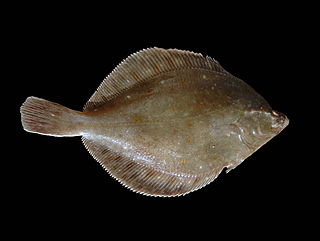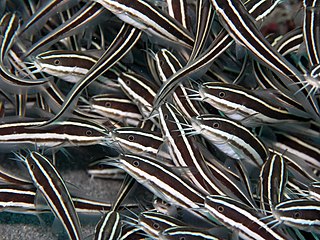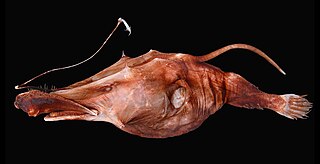
Sardine and pilchard are common names for various species of small, oily forage fish in the herring family Clupeidae. The term 'sardine' was first used in English during the early 15th century; a somewhat dubious folk etymology says it comes from the Italian island of Sardinia, around which sardines were once supposedly abundant.

Anomalopidae are a family of fish distinguished by bioluminescent organs located underneath their eyes, for which they are named. These light organs contain luminous bacteria and can be "shut off" by the fish using either a dark lid or by being drawn into a pouch. They are used to communicate, attract prey, and evade predators.
The Cetomimiformes or whalefishes are an order of small, deep-sea ray-finned fish. Some authorities include the whalefishes as part of the order Stephanoberyciformes, within the superfamily Cetomimoidea. Their sister order, the Beryciformes, includes the flashlight fish and squirrelfish.

Pleuronectidae, also known as righteye flounders, are a family of flounders. They are called "righteye flounders" because most species lie on the sea bottom on their left sides, with both eyes on their right sides. The Paralichthyidae are the opposite, with their eyes on the left side. A small number of species in Pleuronectidae can also have their eyes on the left side, notably the members of the genus Platichthys.

Plotosus is a genus of eeltail catfishes native to the Indian Ocean, the western Pacific Ocean and New Guinea.

The complete anglerfish (Lasiognathus) is a genus of deep-sea anglerfish in the family Thaumatichthyidae, with six species known from the Atlantic and Pacific Oceans. Its lure apparatus appears to consist of a fishing rod, a fishing line, bait, and hooks. It is also distinctive for an enormous upper jaw with premaxillaries that can be folded down to enclose the much shorter lower jaw.

Fish are very diverse animals and can be categorised in many ways. Although most fish species have probably been discovered and described, about 250 new ones are still discovered every year. According to FishBase about 34,800 species of fish had been described as of February 2022, which is more than the combined total of all other vertebrate species: mammals, amphibians, reptiles and birds.
The hooded triplefin is a species of triplefin blenny in the genus Helcogramma. It was described by Richard Rosenblatt in 1960. This species is widespread in the western Pacific Ocean from the Mariana Islands east to Samoa, Fiji and Tonga; it has been recorded from Sabah too.

Photoblepharon palpebratum, the eyelight fish or one-fin flashlightfish, is a species of saltwater anomalopid fish of the order Beryciformes. It is native to the western and central Pacific Ocean where it is found along seaward reefs close to the ocean floor, usually near rocks and corals it can use as cover. At only 12.0 cm (4.7 in) in length, it is a small fish, and more stout than other members of its family. Its body is mostly black, with a line of reflective scales running the length of its body and a distinguishing white spot at the upper corner of its preopercle. Its most notable features are its subocular bioluminescent organs which it likely uses to attract and find prey, confuse predators, and communicate with other fish. These organs are blinked on and off by the fish using a dark lid that slides up to cover them.
Parmops is a genus of flashlight fishes found in the deep waters of the central Pacific Ocean. P. coruscans is found in the Eastern Pacific around Tahiti and P. echinatus is found in the Western Pacific around Fiji.
Photoblepharon is a genus of poorly understood flashlight fishes found around reefs in the western Pacific Ocean (P. palpebratum) and in the western Indian Ocean (P. steinitzi). Both of its species are nocturnal predators, hiding in caves and crevices during the day and emerging at night to feed. They are small fish, 11.0–12.0 cm (4.3–4.7 in) maximum length, and of little commercial value, although fishermen have been known to use their light organs as bait. Like other anomalopids, they are notable for the white organs containing bioluminescent bacteria underneath their eyes, which, by emitting a blue-green light, allow the fish to search for food, evade predators, and communicate with other fish. Both species have black lids that slide up to cover the organ when the fish does not want to emit light. Although similar in appearance, they can be easily distinguished by the preopercle, which has a medium-sized white spot in P. palpebratum, whereas in P. steinitzi, it is much smaller and much darker, or not present at all. Neither species has been evaluated by the International Union for Conservation of Nature (IUCN) and their nocturnal natures make collection difficult and sightings uncommon.
Phthanophaneron harveyi, the Gulf flashlightfish, is a species of saltwater fish of the family Anomalopidae. It is endemic to the Gulf of California. This cryptic fish is the only known member of the genus Phthanophaneron. It was first reported in the Pacific Ocean in 1976 and is extremely rare.
Protoblepharon is a genus of flashlight fishes known from the Pacific Ocean from around the Cook Islands (P. rosenblatti) and off of eastern Taiwan (P. mccoskeri).

Cocotropus is a genus of marine ray-finned fish, velvetfishes belonging to the family Aploactinidae. The genus is found in the Indian and western Pacific oceans.

Pacific spotted scorpionfish, or the stone scorpionfish, is a species of marine ray-finned fish belonging to the family Scorpaenidae, the scorpionfishes. It is found in the eastern Pacific Ocean. It is the largest species in the genus Scorpaena and, like the other species in that genus, it is protected by venomous spines.
Quietula is a genus of fish in the goby subfamily, Gobionellinae. There are two species, both native to the Gulf of California in Mexico. One is endemic to the Gulf, and the other also occurs along the western coast of Baja California and the coast of California. The fish were first described from Guaymas in Sonora, Mexico. The genus name Quietula is from the Latin quietus, meaning "quiet".
Parmops echinatus is a species of flashlight fish found in the western Pacific Ocean. It was first described in 2001 from two specimens caught off the coast of Fiji at depths of 440 m (1,440 ft) and 550 m (1,800 ft).
The flashlight fish is a species of anomalopid fish of the order Beryciformes. It is native to the western Indian Ocean and the Red Sea where it is found near coral reefs. It is a nocturnal predator, hiding in crevices and caves by day and emerging to feed at night. At 11.0 cm (4.3 in) in length, it is small and relatively stout. Its body is mostly solid black, with the exception of white discoloration around its pectoral fins and a lateral line of reflective scales. It is most notable for the bioluminescent organs located underneath its eyes, which it uses to find prey, evade predators, and communicate with other members of its species. Like other Beryciformes, its reproduction is oviparous. It has no commercial value, and this combined with its timid, nocturnal nature makes population sizes and trends unknown. It is listed as Least Concern by the International Union for Conservation of Nature (IUCN) due to a wide distribution and lack of known threats.
Protoblepharon mccoskeri, the Taiwanese flashlight fish, is a flashlight fish species found in the Northwest Pacific off of Taiwan's east coast. It can be found as deep as 300m. It was first described in 2012 from a single specimen caught near Taiwan.
Protoblepharon rosenblatti, the Cook Islands flashlightfish, is a species of flashlight fish found in the waters surrounding the Cook Islands. It can reach lengths of up to 22.0 cm (9 in) and can be found as deep as 274 m (900 ft).







